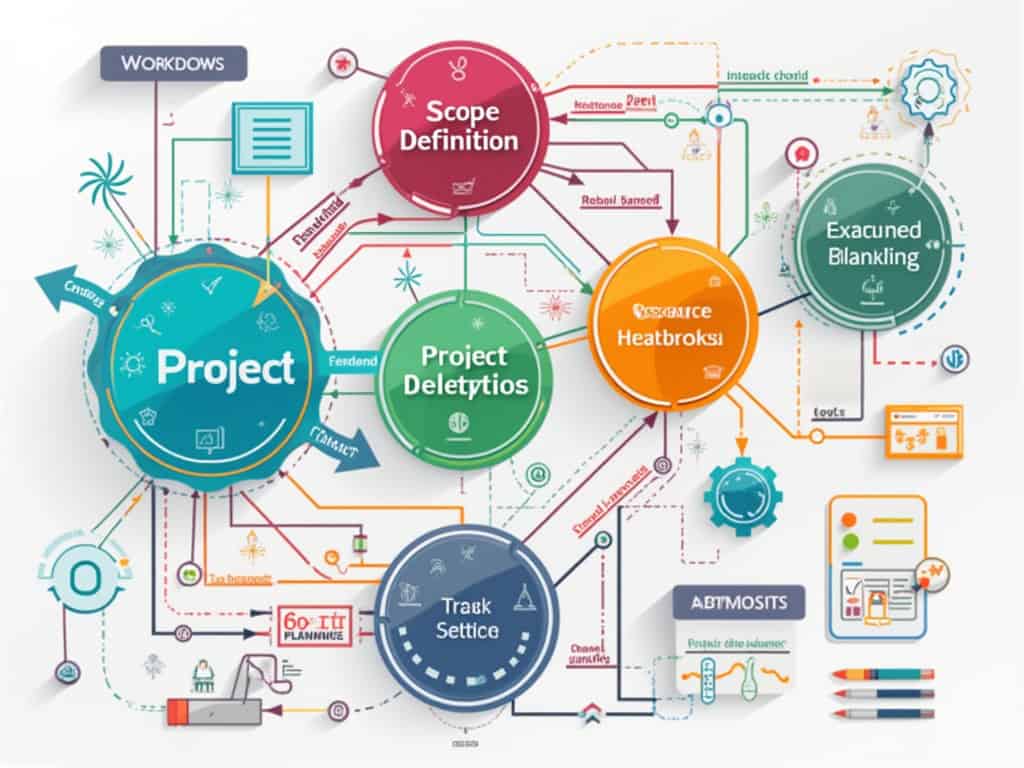
A Well-Designed Project Planning Workflow
A well-designed project planning workflow serves as the critical foundation for successful business execution. It provides a structured process that transforms complex initiatives into manageable, strategic endeavors. By establishing a comprehensive roadmap from conception to completion, you can ensure precise delivery of objectives, maintain budget constraints, and align team efforts with business goals.
Key Takeaways:
- Create a structured project planning workflow that breaks complex projects into manageable components and clear, actionable steps.
- Establish specific, measurable goals that align with broader organizational objectives using the SMART framework.
- Implement robust task decomposition strategies to enhance project visibility and accountability.
- Develop comprehensive resource allocation strategies that match team members’ skills with appropriate tasks.
- Utilize continuous monitoring and feedback loops to optimize workflow performance and drive ongoing improvement.
Effective project planning begins with clear scope definition and realistic goal setting. Breaking down your project into smaller components creates clarity for your team while preventing scope creep. This decomposition technique helps identify dependencies between tasks and establishes a logical sequence for execution.
Resource allocation forms the next crucial step in your workflow. Match team members’ strengths with appropriate responsibilities to maximize efficiency. Consider using specialized project management software to track assignments, deadlines, and progress in real time.
Risk assessment should be integrated throughout your planning process. Identify potential obstacles early and develop contingency plans to address them. This proactive approach minimizes disruptions and keeps projects moving forward even when challenges arise.
Implement regular checkpoints to monitor progress against established milestones. These reviews provide opportunities to make necessary adjustments before small issues become significant problems. Embracing change as a natural part of project evolution allows your team to remain flexible without losing sight of core objectives.
Documentation plays a vital role in successful project execution. Create standardized templates for project plans, status reports, and communication protocols. Consistent documentation facilitates knowledge transfer and ensures all stakeholders remain informed about project status.
Feedback mechanisms complete the workflow cycle by generating insights for continuous improvement. Conduct post-project reviews to identify successful strategies and areas for enhancement. These lessons learned become valuable inputs for future project planning, creating an upward spiral of organizational capability.
The most effective workflows balance structure with flexibility, providing clear direction while allowing teams to adapt to changing circumstances. This balanced approach leads to consistent project delivery that meets both immediate objectives and long-term business goals.
“A well-structured project planning workflow transforms chaos into clarity, empowering teams to navigate complex initiatives with precision and purpose. By aligning actionable goals with organizational objectives, businesses can foster accountability, optimize resources, and drive sustainable success.”
Project Management Foundations
A well-designed project planning workflow serves as the backbone of successful business execution. This structured, sequential process organizes your projects from conception to completion, ensuring you deliver on time, within budget, and meet defined business objectives. Your project planning workflow requires thoughtful development to create a roadmap that guides all project activities.
Effective project planning workflow begins with establishing the foundational elements that support your entire project structure. You’ll need to focus on setting clear goals, breaking down complex work into manageable pieces, allocating resources appropriately, and creating realistic timelines. These core components create a framework that enables your team to execute with precision.
Essential Elements of a Strong Project Planning Workflow
Building an effective project planning workflow requires attention to several key components:
- Goal setting: Define specific, measurable outcomes that align with business objectives
- Task decomposition: Break large initiatives into smaller, manageable work packages
- Resource allocation: Assign appropriate team members and materials to each task
- Timeline management: Establish realistic schedules with built-in flexibility
- Risk assessment: Identify potential obstacles and develop effective risk response planning
- Communication protocols: Establish how project updates will be shared and tracked
The strength of your project planning workflow often determines project success. When properly implemented, it creates visibility, accountability, and alignment across teams. You’ll find that projects with robust planning workflows experience fewer delays, budget overruns, and scope changes than those without structured approaches.
Consider implementing continuous improvement practices within your project planning workflow. By regularly evaluating performance and adjusting processes, you’ll refine your approach over time. This ongoing optimization helps you maintain a project planning workflow that evolves with your organization’s changing needs while consistently delivering successful outcomes.
Projects with formal project management processes are 28 times more likely to be successful than those without.
forbes.com
Defining Clear Project Goals and Objectives
The foundation of any effective project planning workflow begins with establishing concrete goals and objectives. You’ll need to define outcomes that are specific, measurable, achievable, relevant, and time-bound (SMART) to guide your team’s efforts and ensure project success.
Creating measurable objectives helps track progress throughout your project planning workflow. Rather than setting vague goals like “improve customer satisfaction,” specify “increase customer satisfaction ratings by 15% within six months.” This precision enables you to monitor advancement and make data-driven adjustments as needed.
Aligning your project goals with broader organizational strategies is essential for gaining executive support. When your project planning workflow connects directly to company objectives, you’ll secure the resources and backing needed for successful execution. This alignment also helps engage stakeholders effectively throughout the project lifecycle.
Preventing scope creep requires collaboration with key stakeholders during the goal-setting phase. Include representatives from different departments to ensure comprehensive input and build consensus around project deliverables. This collaborative approach in your project planning workflow creates shared ownership and reduces mid-project changes that derail timelines.
Techniques for Effective Goal Definition
Several proven methods can strengthen your project planning workflow during the goal-setting phase:
- Conduct stakeholder interviews to identify expectations and success criteria
- Use the SMART framework to refine objectives into actionable targets
- Create a project charter documenting agreed-upon goals and constraints
- Develop key performance indicators (KPIs) that measure progress toward objectives
- Implement regular project communication checkpoints to validate goals remain relevant
The following table outlines the components of well-defined project objectives within your project planning workflow:
| Component | Description | Example |
|---|---|---|
| Specific | Clearly defines what will be accomplished | Launch new customer portal with self-service features |
| Measurable | Includes quantifiable metrics | Reduce support ticket volume by 30% |
| Achievable | Realistic within resource constraints | Complete implementation within current quarter |
| Relevant | Aligns with business priorities | Supports company goal of improving customer experience |
| Time-bound | Includes target completion date | Fully operational by March 31st |
Clear goals set the foundation for all subsequent stages in your project planning workflow. They inform resource allocation decisions, establish evaluation criteria, and provide the benchmark against which success is measured. Without this clarity, your project risks wasting resources on misaligned activities or delivering outcomes that don’t meet business needs.
Expert Insight: Establishing clear project goals and objectives is crucial for effective project planning, serving as the guiding framework throughout the project lifecycle. Utilize the SMART criteria to define specific, measurable, achievable, relevant, and time-bound outcomes that align with broader organizational strategies, fostering stakeholder engagement and gaining executive support. Collaborate with key stakeholders during the goal-setting phase to build consensus and prevent scope creep, ensuring that all efforts contribute to successful project execution.
Strategic Task Decomposition and Work Breakdown
Creating an effective project planning workflow starts with breaking down complex initiatives into manageable components. Task decomposition forms the backbone of your planning process, allowing you to transform overwhelming projects into achievable segments. You’ll find this strategic approach essential for maintaining control over project scope and execution.
A well-structured Work Breakdown Structure (WBS) serves as your project’s architectural blueprint. This methodology helps you visualize the entire project planning workflow while organizing tasks hierarchically. You can identify critical dependencies between tasks to establish logical sequences and prevent bottlenecks that could derail your timeline.
Start by dividing your project into major phases, then break those phases into specific activities, and finally into individual tasks. This systematic decomposition ensures nothing falls through the cracks in your project planning workflow. For complex projects, consider using this task breakdown structure:
- Primary project phases (planning, development, testing, implementation)
- Secondary work packages within each phase
- Specific activities and deliverables
- Individual tasks with time estimates and resource requirements
- Verification points and quality checks
Visualization tools enhance your project planning workflow by making complex relationships easier to comprehend. Gantt charts display task sequences and timelines in a format that helps stakeholders quickly grasp the project schedule. These visual aids can highlight important milestones and demonstrate how delays in one area might impact the entire project.
When creating your WBS, focus on outcomes rather than activities. Each component should represent a tangible deliverable that contributes to project completion. This deliverable-oriented approach keeps your project planning workflow aligned with strategic objectives.
Optimizing Your Decomposition Strategy
For maximum effectiveness, integrate these techniques into your project planning workflow:
- Apply the 100% rule – ensure your WBS captures all deliverables and work elements
- Maintain consistent detail levels across similar tasks
- Use coding systems to identify related tasks across different project segments
- Establish clear handoff points between team members
- Create a WBS dictionary documenting detailed information about each component
Your decomposition strategy should prevent scope creep by clearly delineating project boundaries. When properly executed, this structured approach provides the foundation for accurate time estimation, resource allocation, and risk management throughout your project planning workflow.
Projects that utilize a Work Breakdown Structure (WBS) are more likely to be completed on time and within budget, as they provide clarity and focus on deliverables.
www.cio.com
Resource Allocation and Team Management
Effective project planning workflow depends on strategic resource allocation and thoughtful team management. You’ll need to match tasks with the right team members while ensuring workloads remain balanced for optimal productivity. Using a systematic approach to resource management provides the foundation for project success.
When assigning tasks within your project planning workflow, consider both technical skills and personal strengths of each team member. This targeted matching improves efficiency and boosts team morale. As noted by project management experts, task assignments that align with individual capabilities can increase productivity by up to 25%.
Here are essential strategies for effective resource allocation in your project planning workflow:
- Conduct skill assessments before assigning responsibilities
- Use resource management software to track availability and workload
- Implement cross-training to increase team flexibility
- Establish clear communication channels for resource-related concerns
- Create contingency plans for unexpected resource shortages
A well-structured resource allocation matrix can transform your project planning workflow. The table below illustrates how you might organize this information:
| Team Member | Primary Skills | Current Workload | Available Hours | Project Assignments |
|---|---|---|---|---|
| Sarah K. | Data Analysis, Python | 65% | 14 hrs/week | Market Research, Data Modeling |
| Marcus T. | UX Design, Prototyping | 80% | 8 hrs/week | Interface Mockups |
| Priya L. | Backend Development | 40% | 24 hrs/week | API Integration, Database Setup |
Regular workload balancing is crucial to maintaining productivity throughout your project planning workflow. You should schedule weekly resource reviews to address project constraints and dependencies that may impact team capacity. This proactive approach helps prevent burnout while ensuring critical path activities remain on schedule.
Managing Team Dynamics
Beyond technical resource allocation, your project planning workflow must address team dynamics. Establishing clear project communication protocols ensures everyone understands their responsibilities and deadlines.
Consider implementing daily standup meetings within your project planning workflow to facilitate quick updates and identify potential bottlenecks. These brief check-ins promote accountability while providing opportunities to reallocate resources as needed. For distributed teams, digital collaboration tools can streamline this process while maintaining workflow continuity.
Your project planning workflow should also include mechanisms for recognizing team achievements. Recognition reinforces positive behaviors and motivates continued high performance. Simple acknowledgments during team meetings or more formal rewards can significantly impact team morale and project outcomes.
Expert Insight: To optimize resource allocation and enhance team management in your project planning workflow, prioritize matching tasks with team members’ technical skills and personal strengths. Conduct skill assessments and employ resource management software to balance workloads effectively, boosting productivity by up to 25%. Implement regular communication touchpoints and recognition mechanisms to maintain team morale and address any potential bottlenecks swiftly.
Project Timeline and Risk Management
Creating a structured project planning workflow requires careful attention to timelines and potential risks. You’ll need to develop comprehensive schedules while simultaneously preparing for obstacles that could derail your progress.
Your project planning workflow should begin with timeline development. Start by mapping all deliverables against specific dates, ensuring each task has realistic completion timeframes. Break down your schedule into phases with clear milestones to track progress effectively. Include dependencies between tasks to visualize how delays in one area might impact others.
Buffer times are essential components of any successful project planning workflow. These strategic gaps between activities provide flexibility when unexpected issues arise. Adding 10-15% contingency time to critical path activities can prevent cascading delays throughout your project.
Here are key elements to include in your timeline development:
- Clear start and end dates for each project phase
- Milestone markers for significant deliverables
- Resource allocation periods
- Dependency mapping between tasks
- Buffer zones for high-risk activities
- Regular check-in points for progress reviews
Risk management forms the protective layer of your project planning workflow. Effective risk response planning begins by identifying potential threats through team brainstorming sessions and reviewing similar past projects. Categorize risks by probability and impact to prioritize your mitigation strategies.
Risk Mitigation Strategies
Your approach to risk should be proactive rather than reactive. Each identified risk in your project planning workflow deserves a specific response strategy. The following table outlines common risk management approaches:
| Risk Response | Description | When to Use |
|---|---|---|
| Avoidance | Eliminating the threat by changing project approach | For high-impact, high-probability risks |
| Mitigation | Reducing probability or impact through preventive action | For medium to high risks with feasible control measures |
| Transfer | Shifting risk responsibility to third parties | For specialized risks better handled by experts |
| Acceptance | Acknowledging risk without action | For low-impact risks or those too costly to address |
Implementing risk response strategies requires regular monitoring throughout your project planning workflow. Establish trigger points that activate contingency plans when certain conditions occur. This proactive stance helps maintain project momentum despite inevitable challenges.
Your project planning workflow must include regular timeline reviews and risk reassessments. Schedule these at key milestone points to evaluate progress and adjust both timelines and risk responses as needed. This cyclical approach ensures your project planning workflow remains adaptable to changing conditions while maintaining focus on delivery targets.
Remember that documenting your timeline decisions and risk management strategies creates valuable reference material for future projects, improving your organization’s project planning workflow capabilities over time.
Workflow Optimization and Continuous Improvement
Effective project planning workflow requires continuous monitoring and refinement to achieve optimal results. You’ll need a systematic approach to track progress, measure performance, and implement improvements throughout your project lifecycle.
Setting up proper monitoring mechanisms is essential for maintaining your project planning workflow. You can establish KPIs tailored to your specific project objectives that provide clear visibility into progress. These metrics might include task completion rates, resource utilization percentages, budget variance, and schedule adherence.
Here’s how to implement effective monitoring within your project planning workflow:
- Create dashboards that display real-time project performance data
- Schedule regular check-in meetings to discuss progress and roadblocks
- Implement automated alerts for deadlines and budget thresholds
- Document lessons learned throughout the project planning workflow
- Use project success criteria to measure effectiveness
Implementing feedback loops is crucial for workflow optimization. By gathering input from team members and stakeholders at regular intervals, you can identify bottlenecks and improvement opportunities. This creates a culture of continuous enhancement in your project planning workflow.
Leveraging Technology for Workflow Improvement
The right technology can transform your project planning workflow from good to exceptional. Project management software automates repetitive tasks, standardizes processes, and provides valuable analytics to drive decisions. When selecting tools, prioritize those that integrate with your existing systems and offer customization options.
Modern project management software capabilities that enhance your project planning workflow include:
- Automated task assignments and dependency tracking
- Real-time collaboration features for distributed teams
- Custom workflow templates for consistent project execution
- Resource allocation visualization and optimization
- Integrated time tracking and budget management
- Scenario planning tools for risk assessment
Don’t let your project planning workflow stagnate. Regularly assess your processes against industry best practices and be willing to adapt. Organizations that excel at project planning workflow maintain flexibility while adhering to proven methodologies.
For maximum effectiveness, combine technology with human judgment. While automation streamlines your project planning workflow, successful projects still require leadership to make critical decisions based on both data and experience. By balancing technological solutions with strategic oversight, you’ll create a project planning workflow that consistently delivers results.






